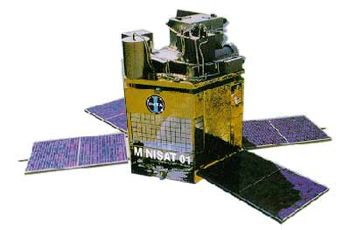
Home - Search - Browse - Alphabetic Index: 0- 1- 2- 3- 4- 5- 6- 7- 8- 9
A- B- C- D- E- F- G- H- I- J- K- L- M- N- O- P- Q- R- S- T- U- V- W- X- Y- Z
Minisat
 Minisat-01 Credit: Manufacturer Image |
Status: Operational 1997. First Launch: 1997-04-21. Last Launch: 1997-04-21. Number: 1 . Gross mass: 209 kg (460 lb).
The first series were Minisat-0 technology satellites, to be followed by Minisat-1 observation satellites and Minisat-2 communications satellites. The Minisat-01 carried the EURD extreme ultraviolet spectrograph to study interstellar gas, the LEGRI gamma ray burst detector, and the CPLM microacceleration in liquids experiment.
More at: Minisat.
Family: Medium earth orbit, Technology, Technology satellite. Country: USA. Launch Vehicles: INTA, Pegasus, Pegasus XL. Launch Sites: Gran Canaria DZ. Agency: CASA. Bibliography: 2, 4, 12839.
1997 April 21 - . 11:59 GMT - . Launch Site: Gando. Launch Complex: Gran Canaria DZ. Launch Pad: 27.0 N x 15.3 W. Launch Platform: L-1011. LV Family: Pegasus. Launch Vehicle: Pegasus XL.
- Minisat-01 - . Mass: 209 kg (460 lb). Nation: USA. Agency: INTA. Manufacturer: CASA. Class: Technology. Type: Navigation technology satellite. Spacecraft: Minisat. Decay Date: 2002-02-26 . USAF Sat Cat: 24779 . COSPAR: 1997-018A. Apogee: 580 km (360 mi). Perigee: 561 km (348 mi). Inclination: 151.00 deg. Period: 96.00 min. Minisat-01 carried the EURD extreme ultraviolet spectrograph to study interstellar gas, the LEGRI gamma ray burst detector, and the CPLM microacceleration in liquids experiment. Air dropped in Gran Canaria DZ..
Back to top of page
Home - Search - Browse - Alphabetic Index: 0- 1- 2- 3- 4- 5- 6- 7- 8- 9
A- B- C- D- E- F- G- H- I- J- K- L- M- N- O- P- Q- R- S- T- U- V- W- X- Y- Z
© 1997-2019 Mark Wade - Contact
© / Conditions for Use